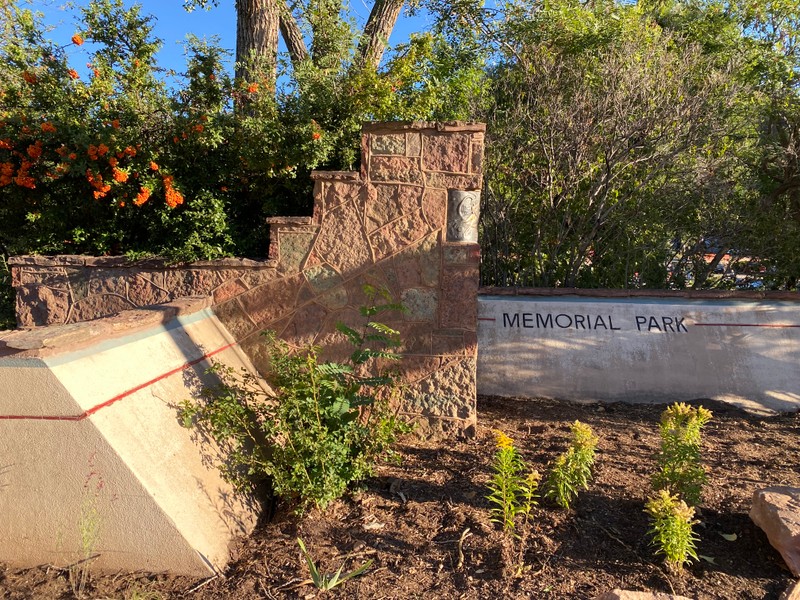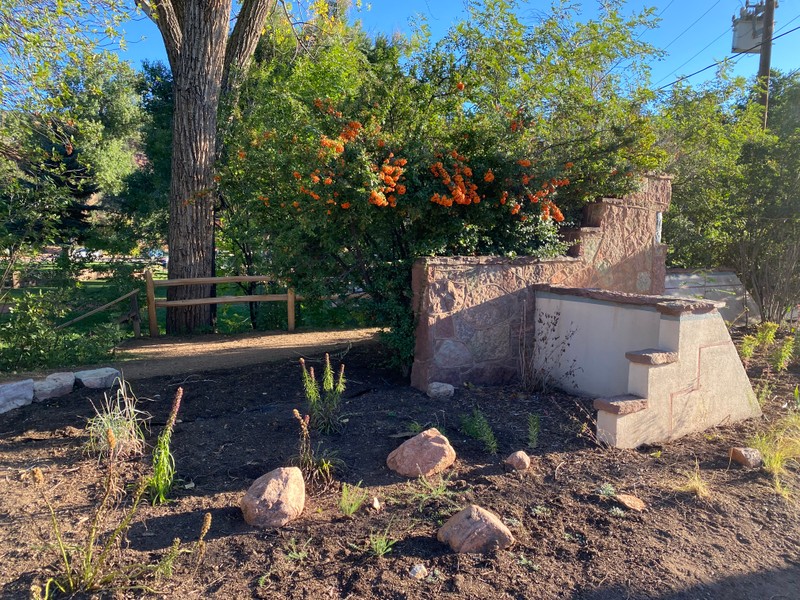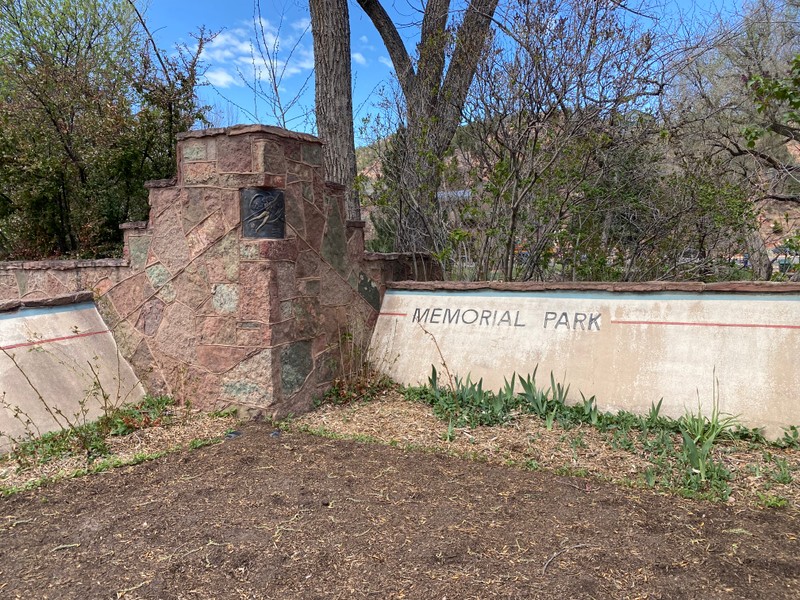Memorial Park Headstone Corner Garden Organic Landscape Conversion
Introduction
Text-to-speech Audio
Manitou Springs' Memorial Park Headstone Corner Garden is one of the city's newest, situated at the northwest corner of Manitou Avenue and Old Man's Trail. Looking for ways to increase the community's pollinator footprint while decreasing irrigation requirements, this historical marker corner garden exemplifies incorporating both waterwise plants and food for hard working pollinators. Plants featured here include: rabbitbrush, tufted hairgrass, ruby muhly, artemisia sp., apache plume, mahonia repens, red yucca, blue grama, pine leaf penstemon, sedum, sulfur buckwheat, narrow leaf coneflower, anise hyssop, butterfly milkweed, evening primrose, Lewis' flax, chocolate flower, desert four o'clock, rocky mountain penstemon, gayfeather, and ornamental crabapple tree.
Images


Memorial Park Headstone Corner Garden
.jpg)
Memorial Park Headstone Corner Garden

Backstory and Context
Text-to-speech Audio
Memorial Sign Corner Organic Landscape Conversion from irrigated blue grass to water wise plantings / pollinator emphasis. Organic chemical free method of renewing an overgrown area by the combination of Solarization and Sheet Mulching methods.
Identification of Site conditions:
Hot southeast corner exposed to high asphalt temperatures, windy and slope drainage which winter killed often where the intensive care blue grass was difficult and ineffective for quality results. To save on water and create more effective maintenance ROI it is an ideal location for organic conversion. This method was also used to convert an overgrown weedy garden plot to the Mansions Edible Floral Community Garden behind City Hall. Many yard treatments are lately using the broadcast rock mulch and landscape fabric technique which is touted as maintenance free, but in reality, weeds return in a few years leading to the use of chemical herbicide use which is detrimental to the ground water health and more immediate our pollinator populations and is very labor intensive and expensive to change so chemical treatments continue.
Solarizing method instead heat treats the undergrowth starving the weeds of light and eventually kills them but keeps the soil undisturbed and the valuable organic matter remains so no need to remove sod. Solarizing with Black plastic, which can be removed and reused, is the heat treatment method. Sheet mulching is the addition of cardboard to suppress growth with mulch/soil added on top for chemical free reworking weedy or grassy areas. It is easy labor, inexpensive, so healthy soil, air and water quality remaining while the cardboard breaks down over time so does not need to be removed. This adds to longer root suppression with new plants on top. It is best to use this method during the longest, hottest days of summer. The goal is to get soil temperatures under the plastic above 140 degrees. It is easier to reach these temperatures in June through August. This is a process that will last for a couple months so for best results plan ahead in your planting schedule so solarization has enough time to work. Some of the more aggressive weeds or tougher grasses will not be eliminated in just a few weeks. The heat must have time to stress the plants enough to weaken to where they will not come back. Rototilling or some type of soil improvements afterward may be needed for providing more friable planting medium and incorporating more organic matter and oxygen for new plants to thrive. To sufficiently suppress any regrowth, patience is key to a successful refresh of the area and new palette for the design and best long-term results. Any regrowth should be dug out right away so not allowed to repopulate.
Its best to know the species you are trying to kill first and whether they are perennials or annuals. If they are perennial weeds or grasses a larger solarization time would be needed while annual weeds may just need a month to kill out. Some common Manitou perennial persistent weeds needing more extensive solarization times to include: Bouncing Bett; Bindweed; Campanulas; spreading type grasses; (all have aggressive root systems).
MANITOU SPRINGS POLLINATOR DISTRICT
The creation of this district is an outgrowth of work begun in 2018 by the Manitou Springs Pollinator Project. Their mission is “to enhance the natural environment of Manitou Springs to make it a more pollinator friendly city”. In September of 2019, Manitou Springs City Council Adopted a Resolution Establishing the Commitment to Have a Sustainable Environment and An Ambitious Response to Climate Change for the City of Manitou Springs. The first of seventeen actions states, “Protect pollinators and ecosystem health through reconfirming our commitment to organic land management and, beginning immediately, expand the use of pollinator-friendly plants and practices on City and private properties”. Manitou Springs School District 14 has also committed to supporting this project.
Over the winter of 2018-2019 it was discovered that at least eight beehives in Manitou Springs were abandoned by the bees, or the bees had died inside the hive. Aware that Pollinator populations have been declining nationwide, and that pollinator health and diversity play a critical role in the food supply for wildlife and people, project members researched creating a more robust program. This led to the discovery of a supported Pollinator District Program developed by the Butterfly Pavilion in Westminster, Colorado. https://butterflies.org/copollinatornetwork/. Pollinator Project members are sponsoring Amy Yarger, Horticulture Director of the Butterfly Pavilion, to do a public presentation in Manitou Springs about Pollinator Communities during the month of June, 2020. Our goal is for Manitou Springs to become a Municipal Pollinator District.
What is a Pollinator District?
According to the Colorado Pollinator Network, “A Pollinator District is a community that is absolutely committed to conserving and improving habitat for pollinators in all aspect of operations. A Pollinator District is a development, including businesses, schools, public facilities and parks, designed, constructed and maintained in such a way that pollinator habitat demonstrates a net gain over the footprint of development. A Pollinator District engages all of the people who live, work and play there in this vital work; community members are vital resources who become citizen scientists, beekeepers, gardeners and stewards of the land. A Pollinator District is a long-term commitment, because these habitats and the populations of pollinators that rely on them take years to establish and thrive”.
Sources
Plant list provided by Skyler Beck with the City of Manitou Springs on 6.2.22.
Memorial Sign Corner Organic Landscape Conversion backstory provided by Mary Ellen Montgomery, Manitou Springs City Gardener on 6.14.22.
Joan Stang photo September 2022
Joan Stang photo September 2022
Joan Stang photo May 2022
Joan Stang photo May 2022
